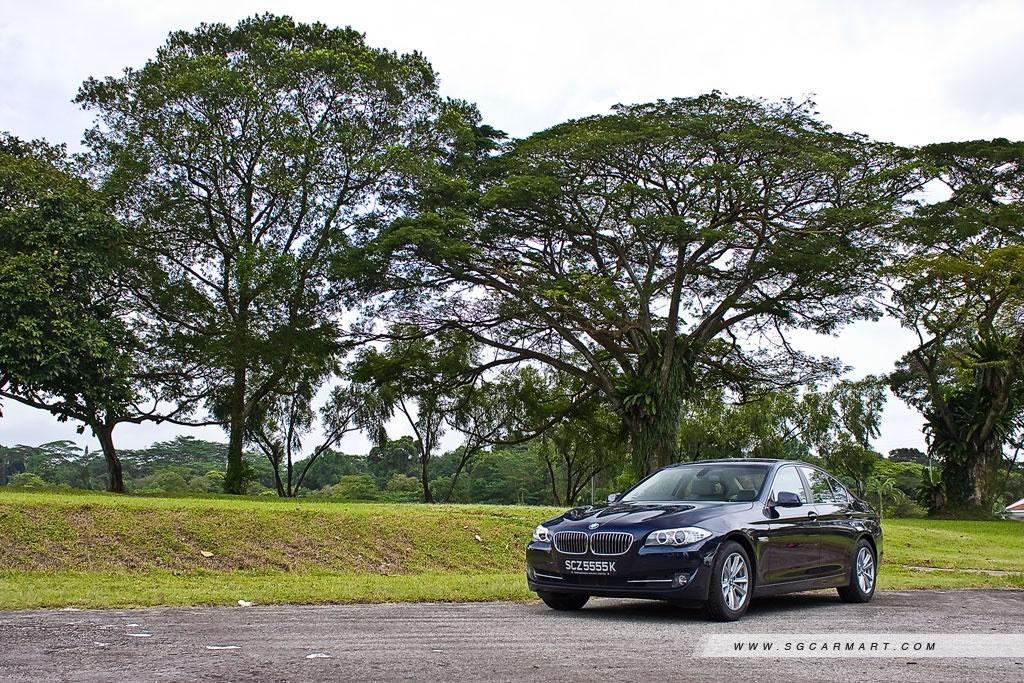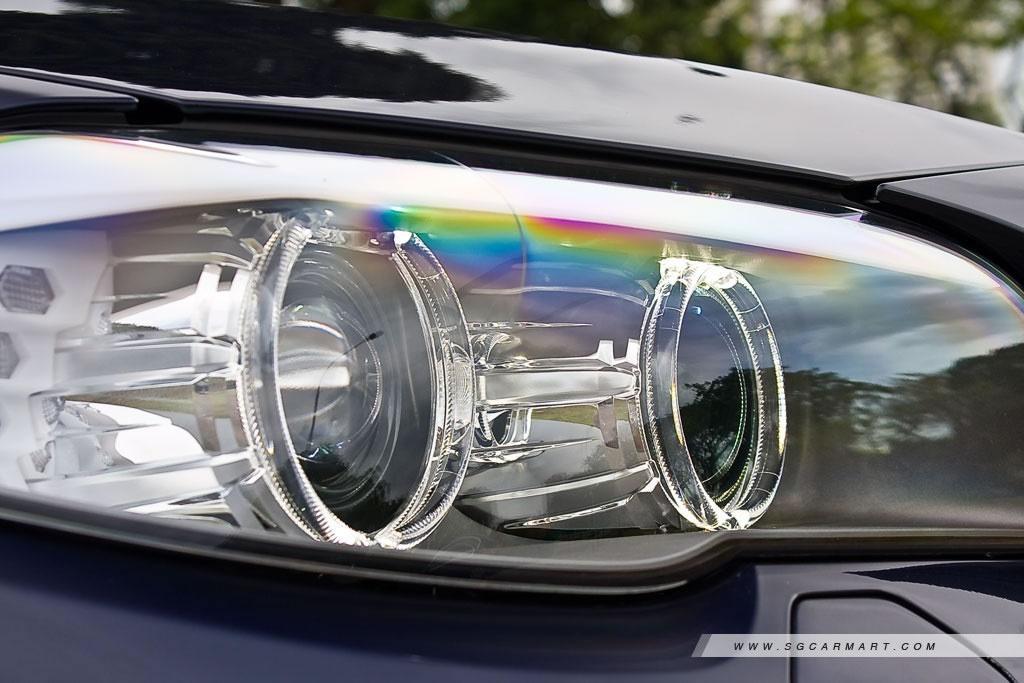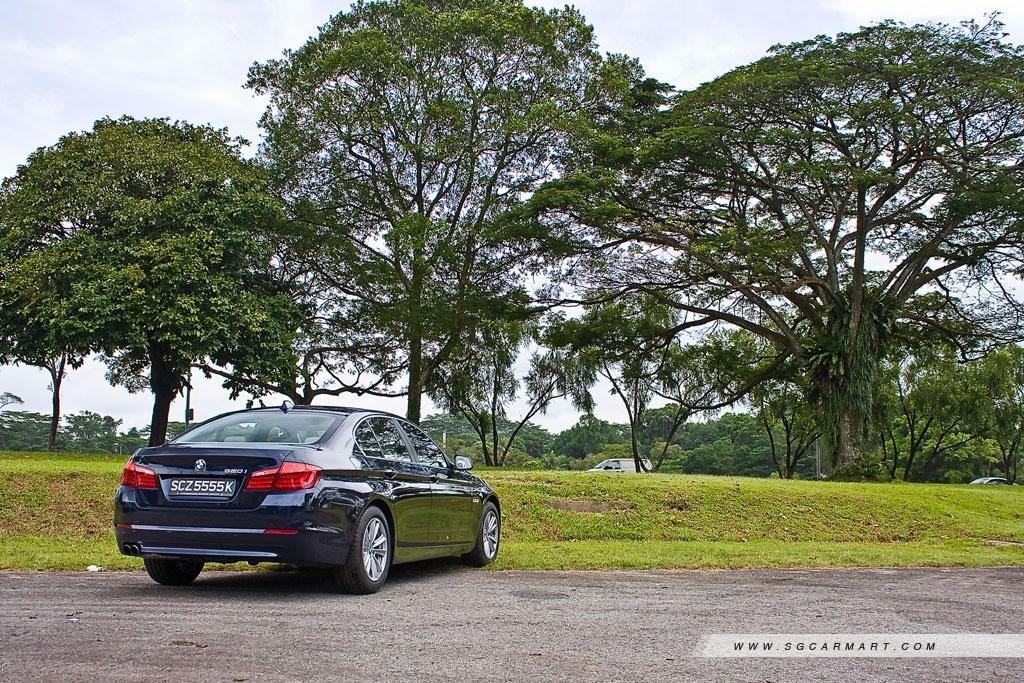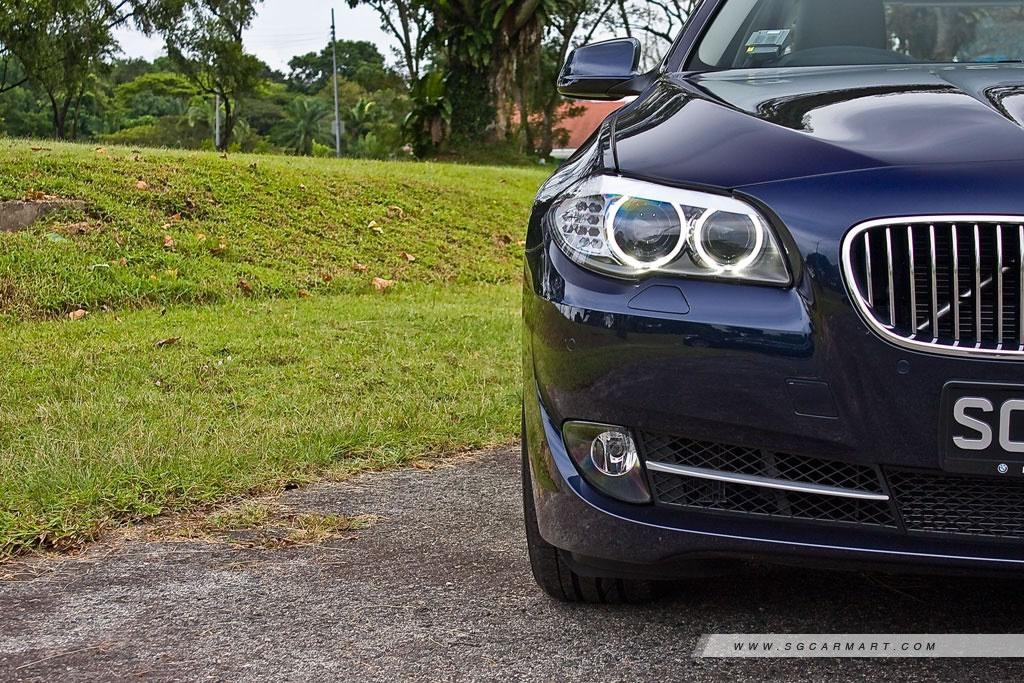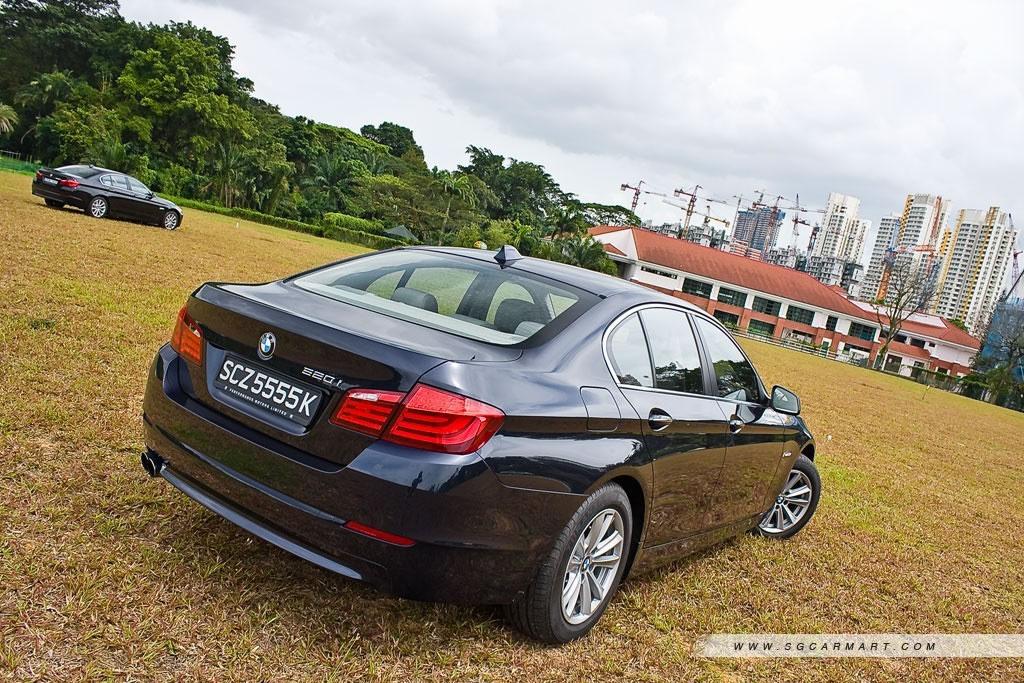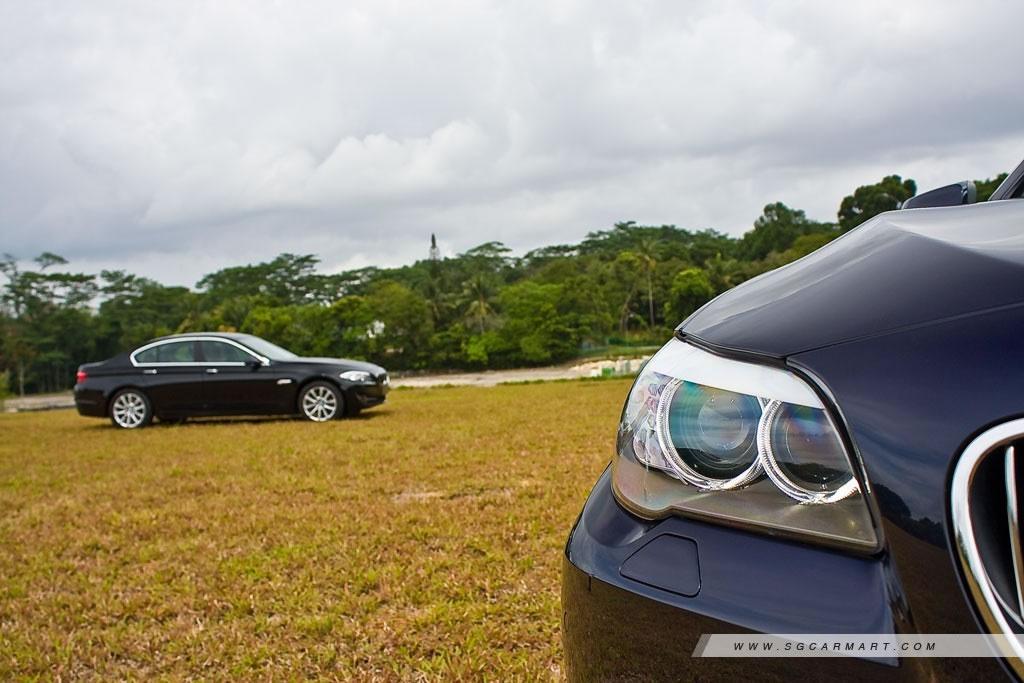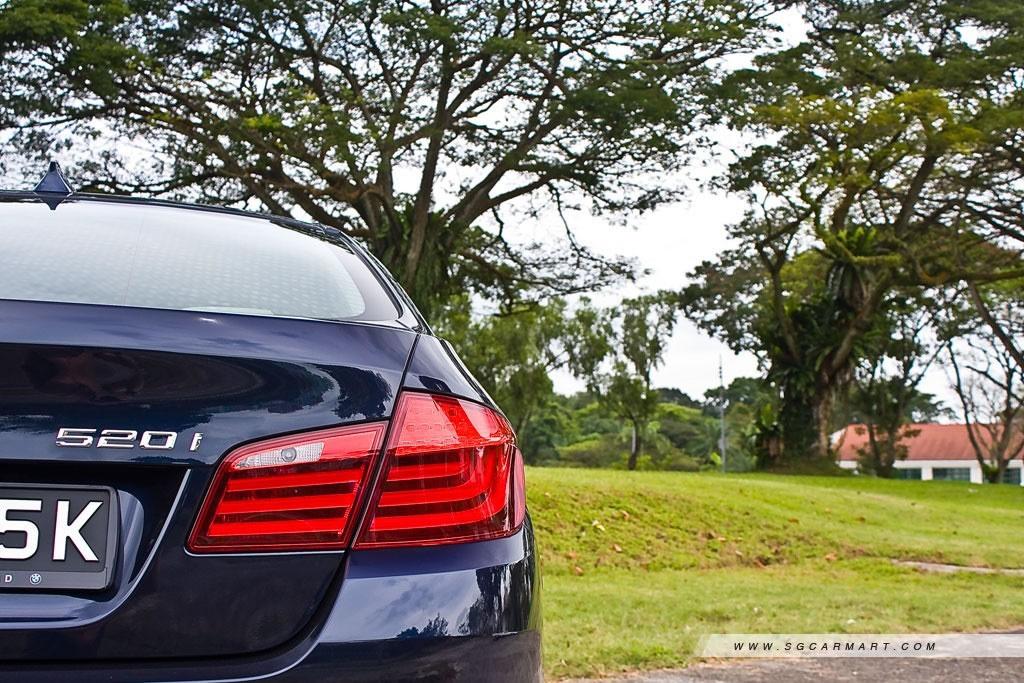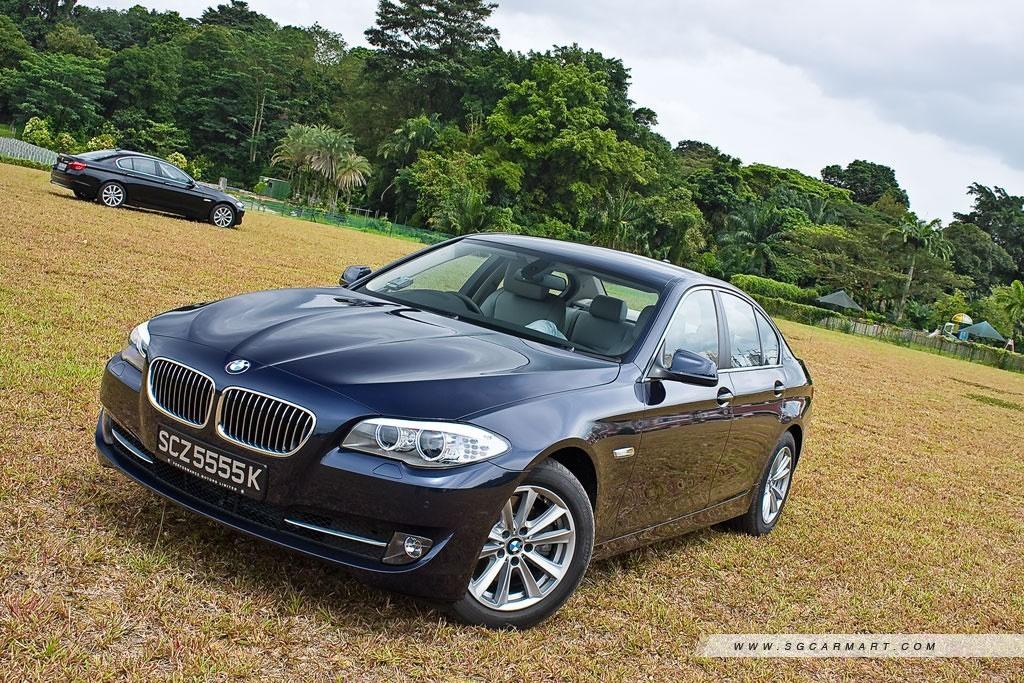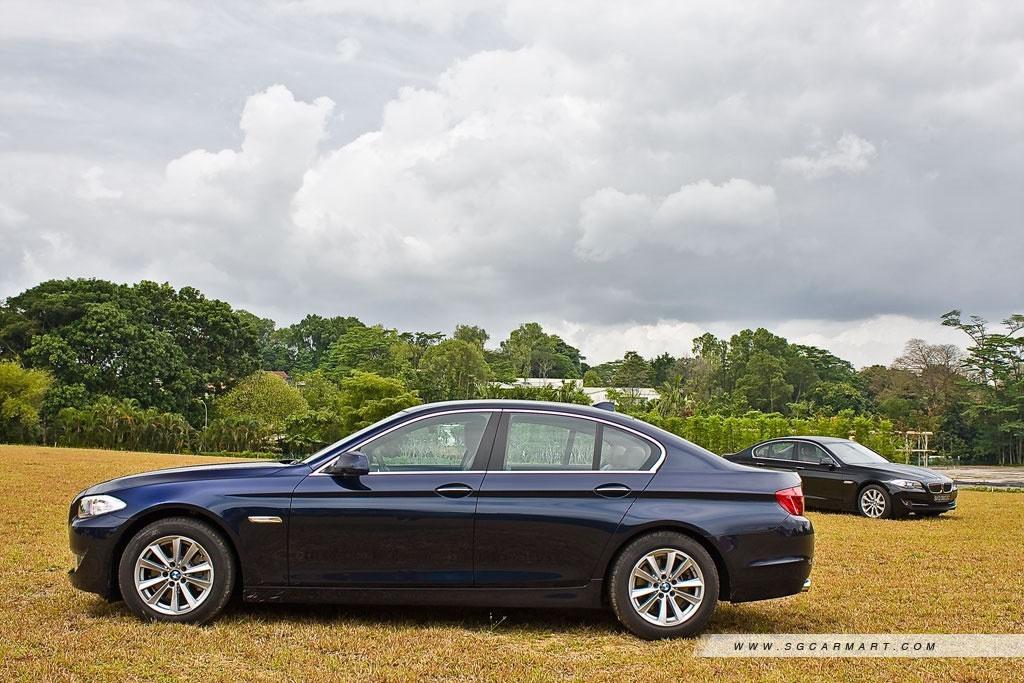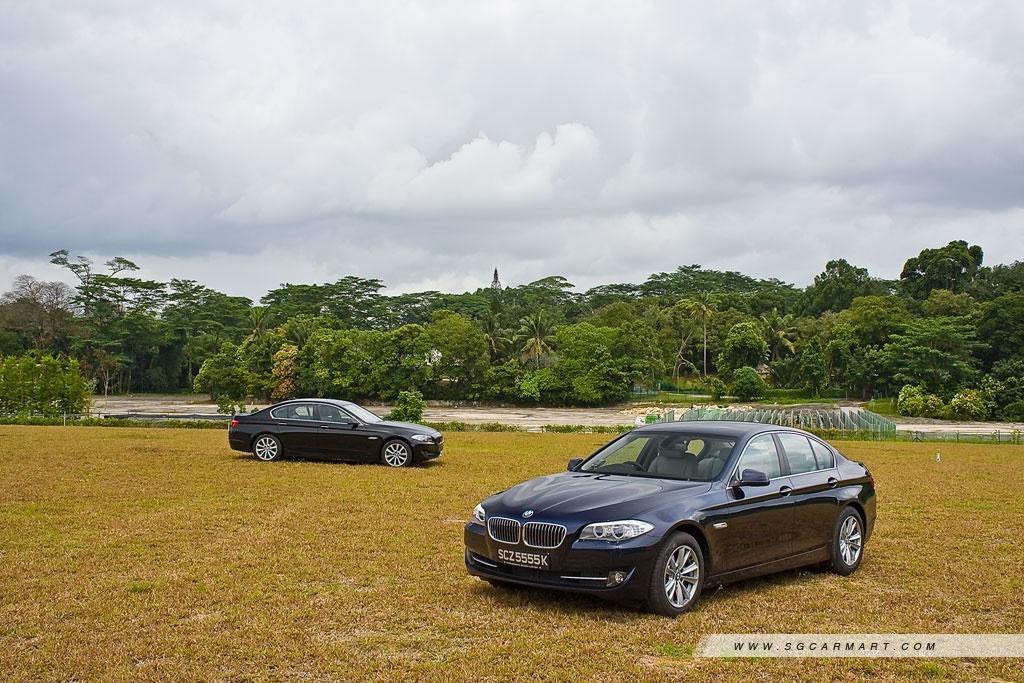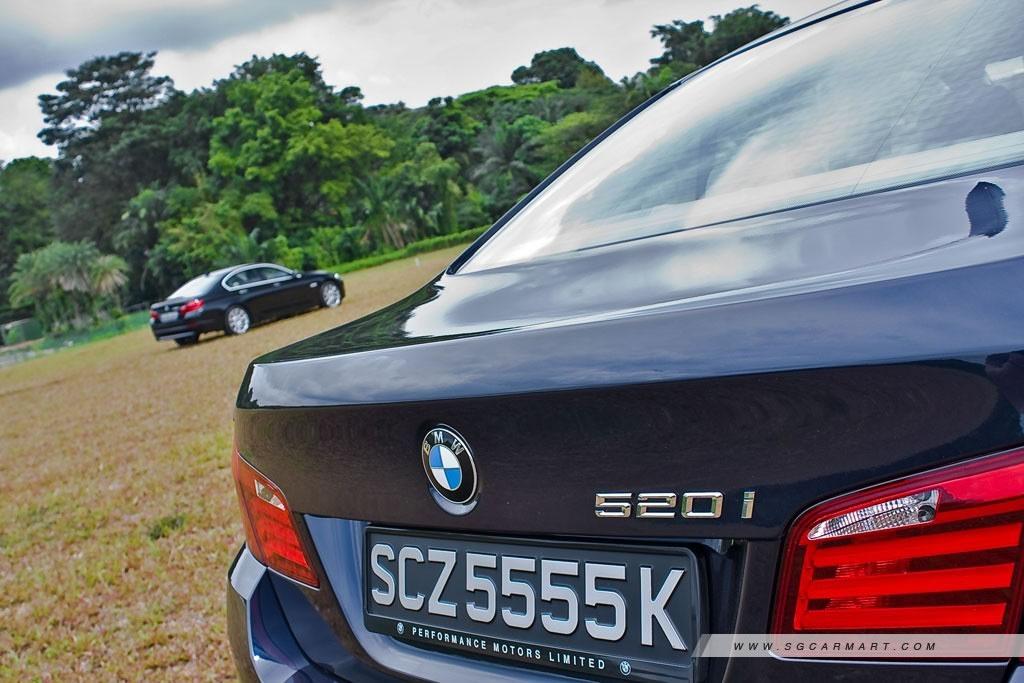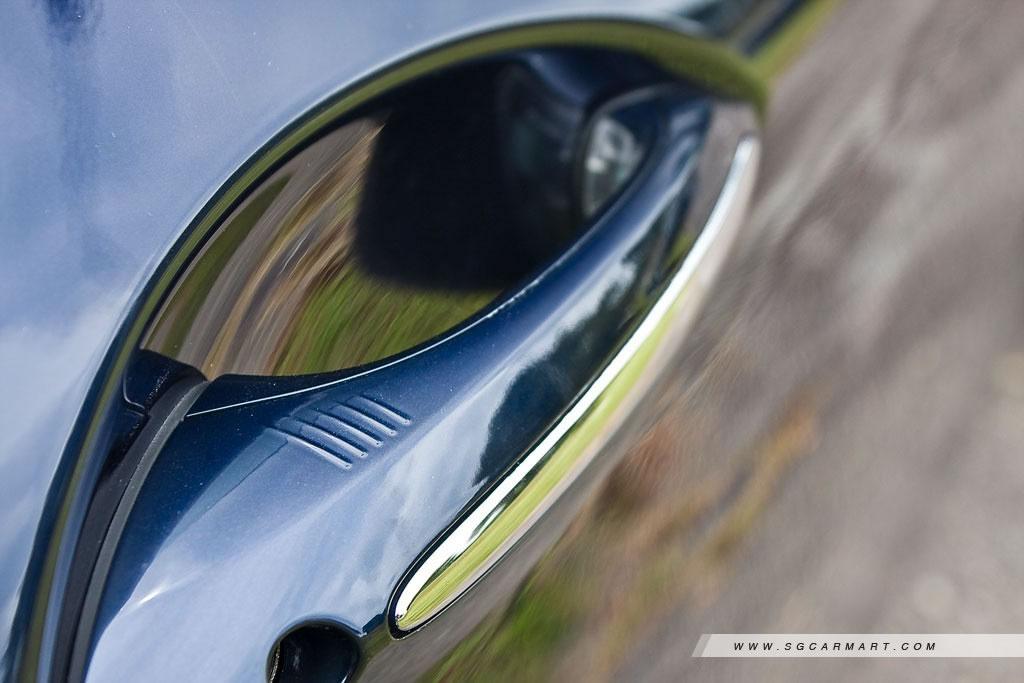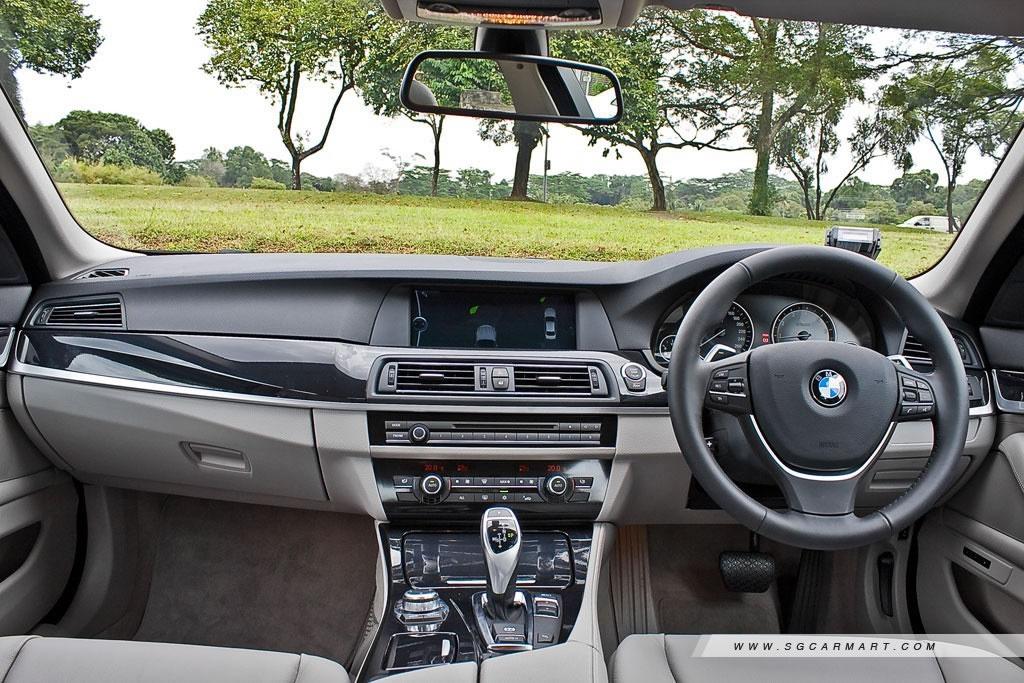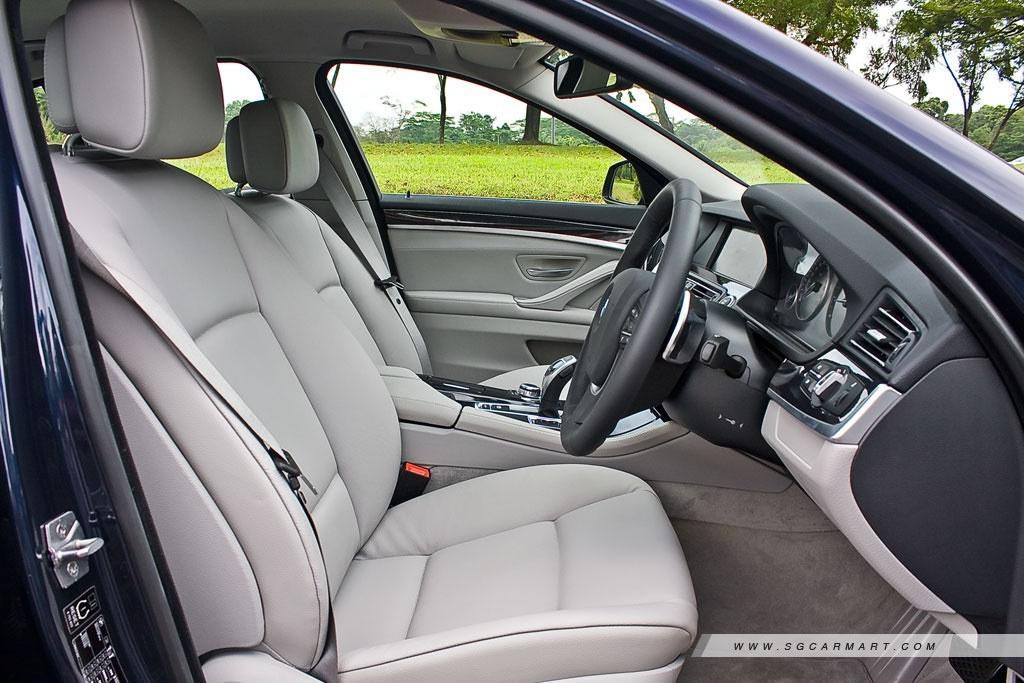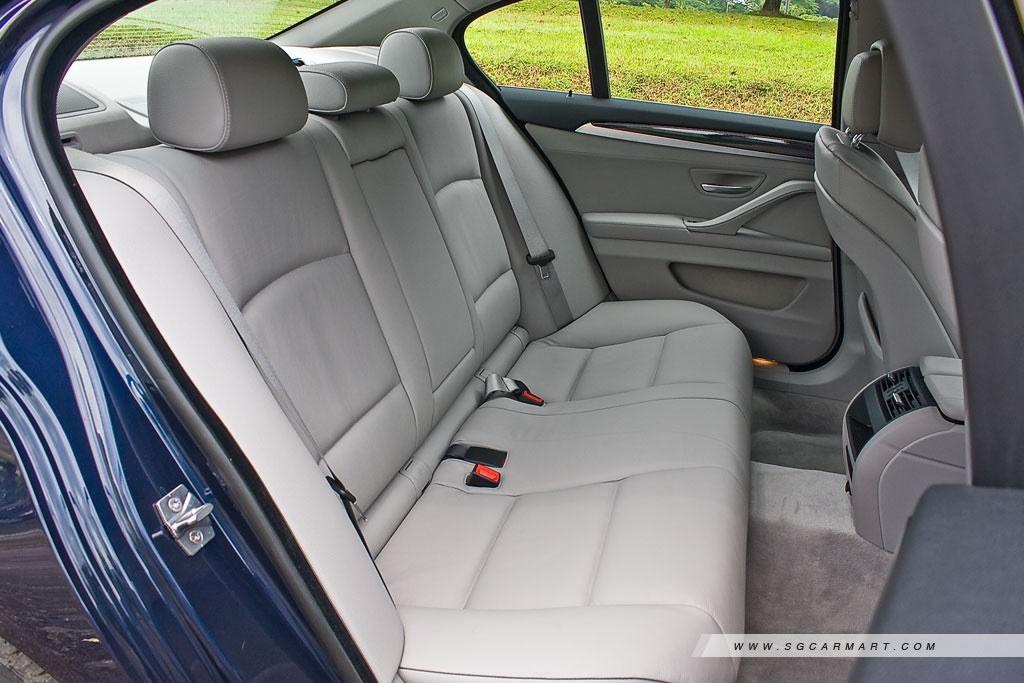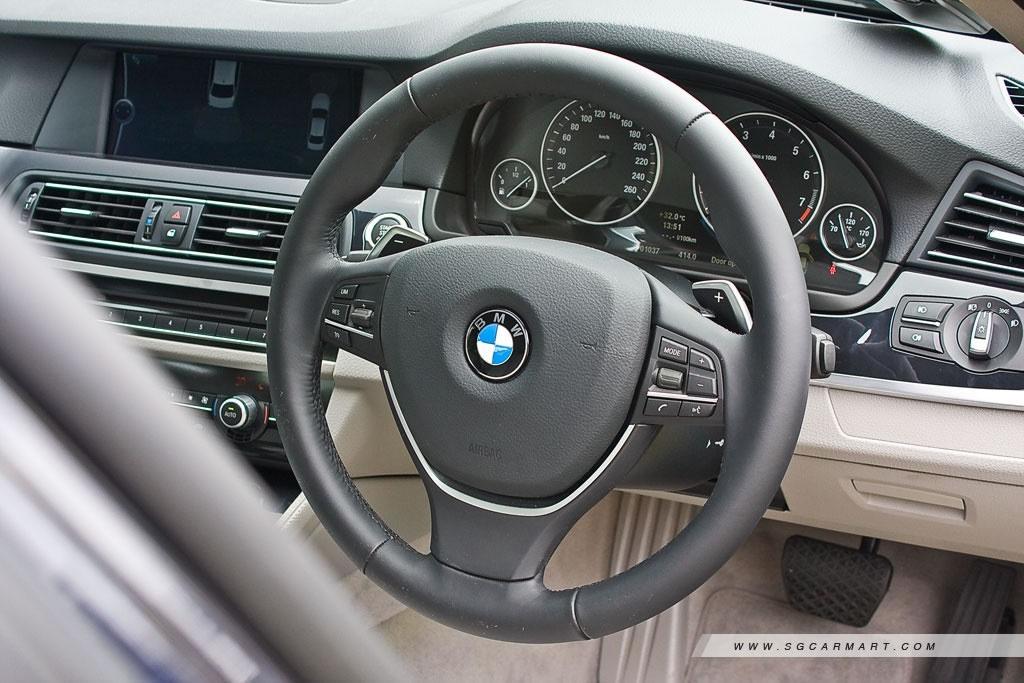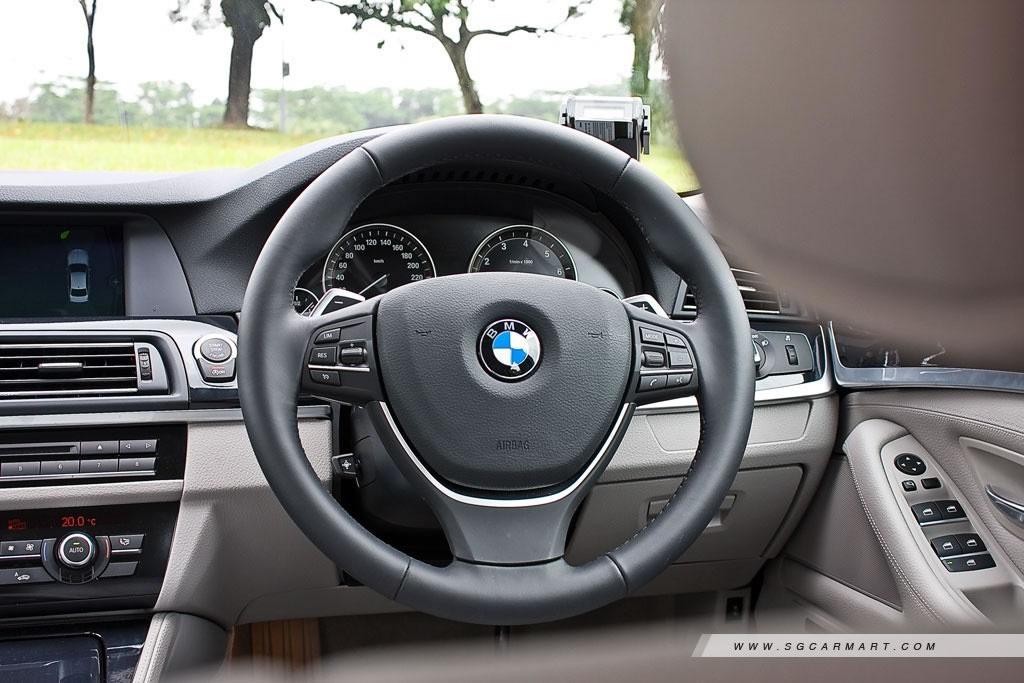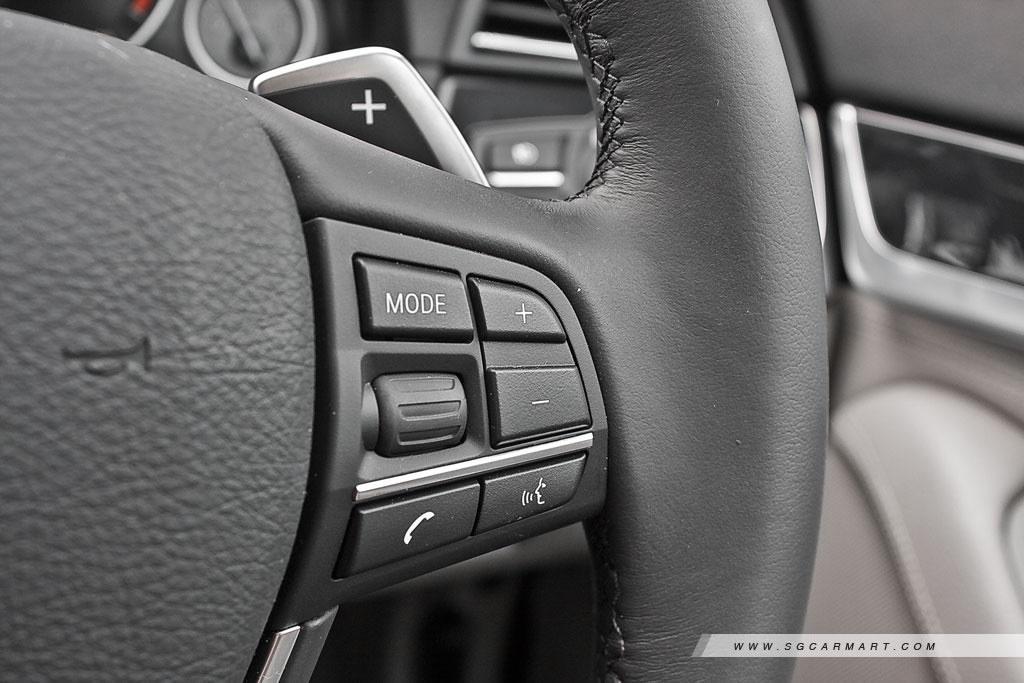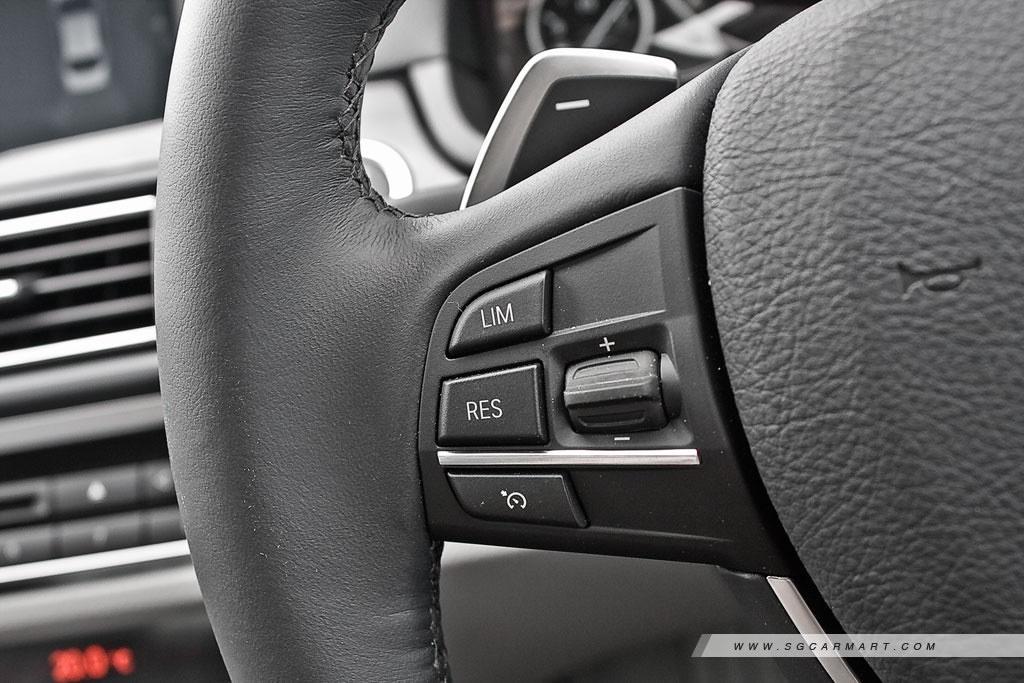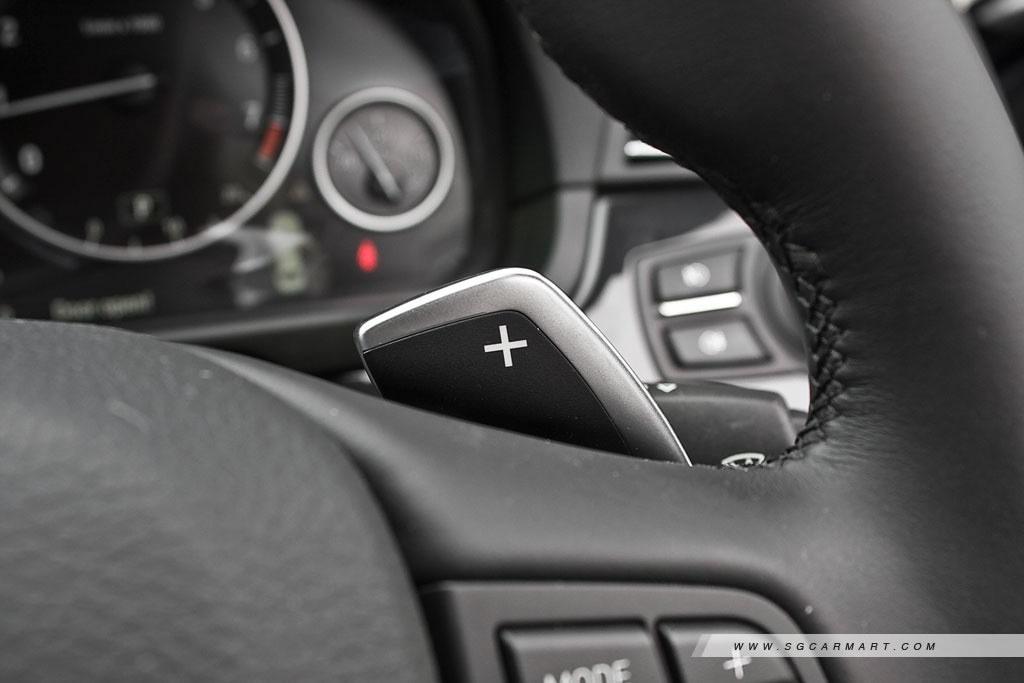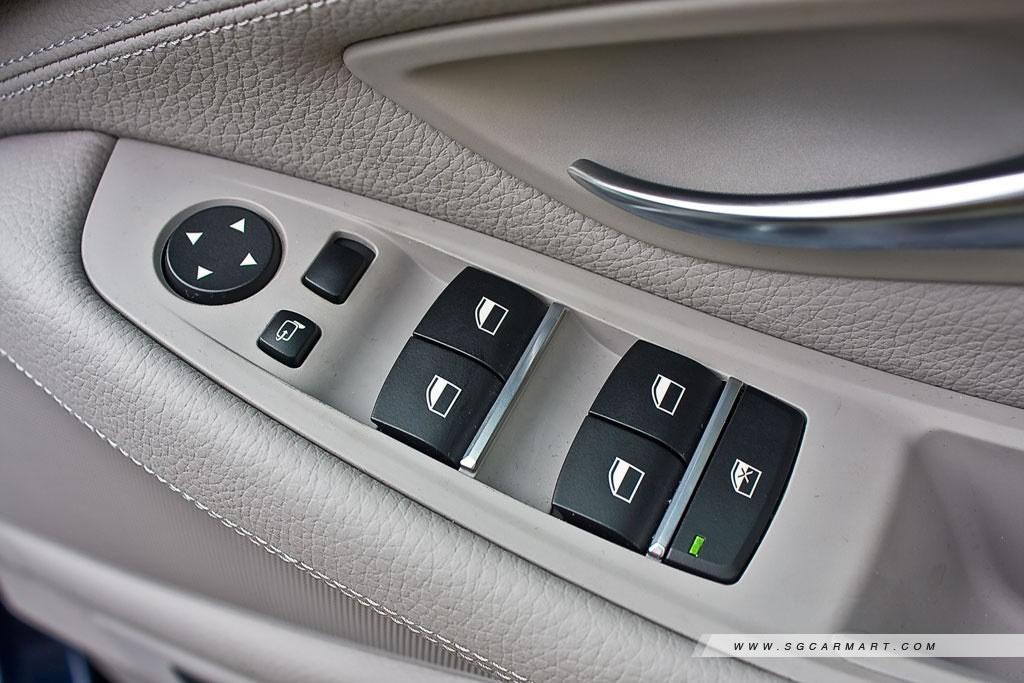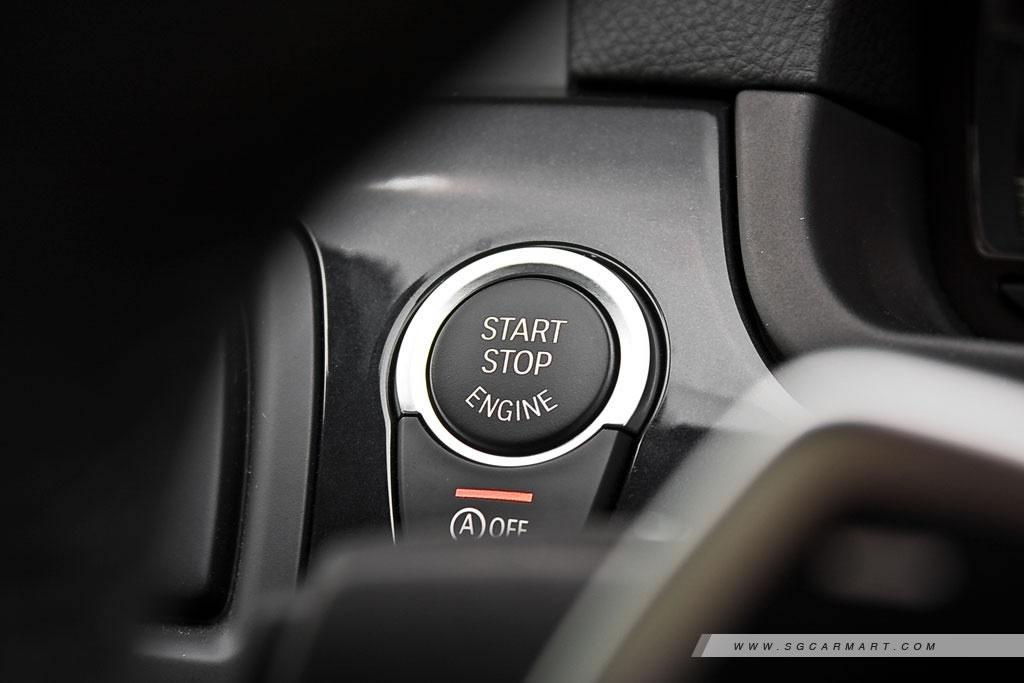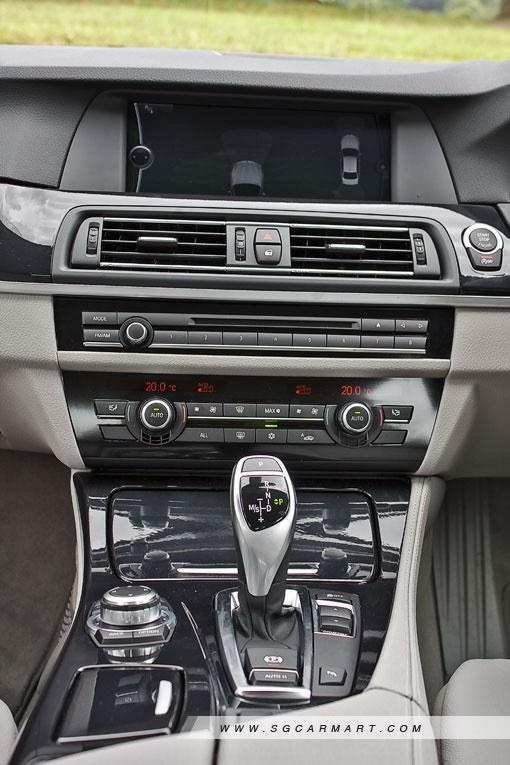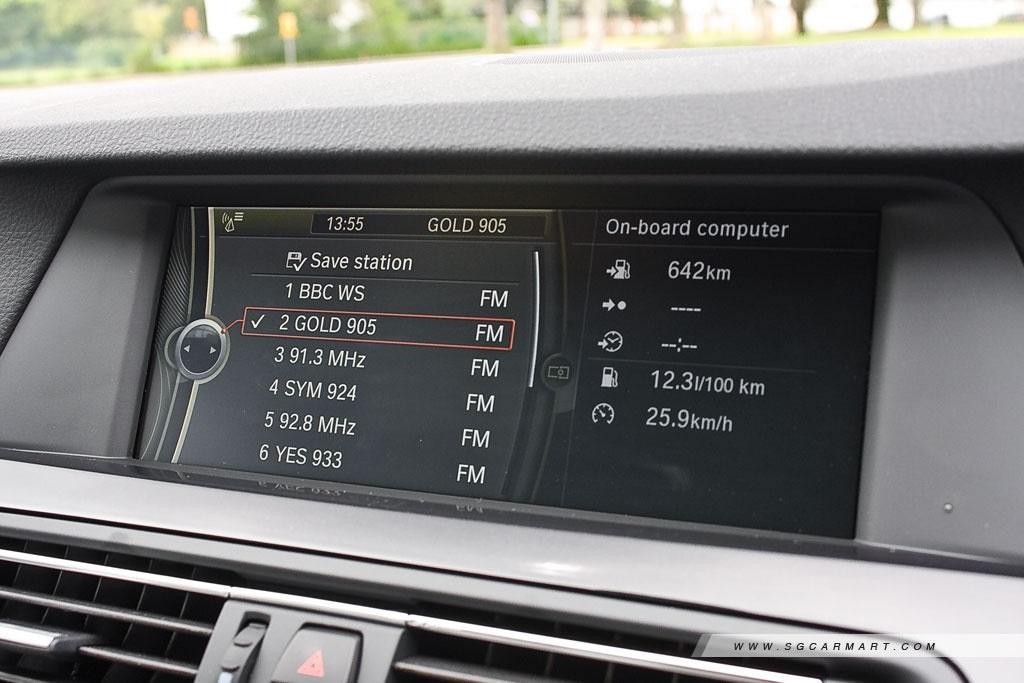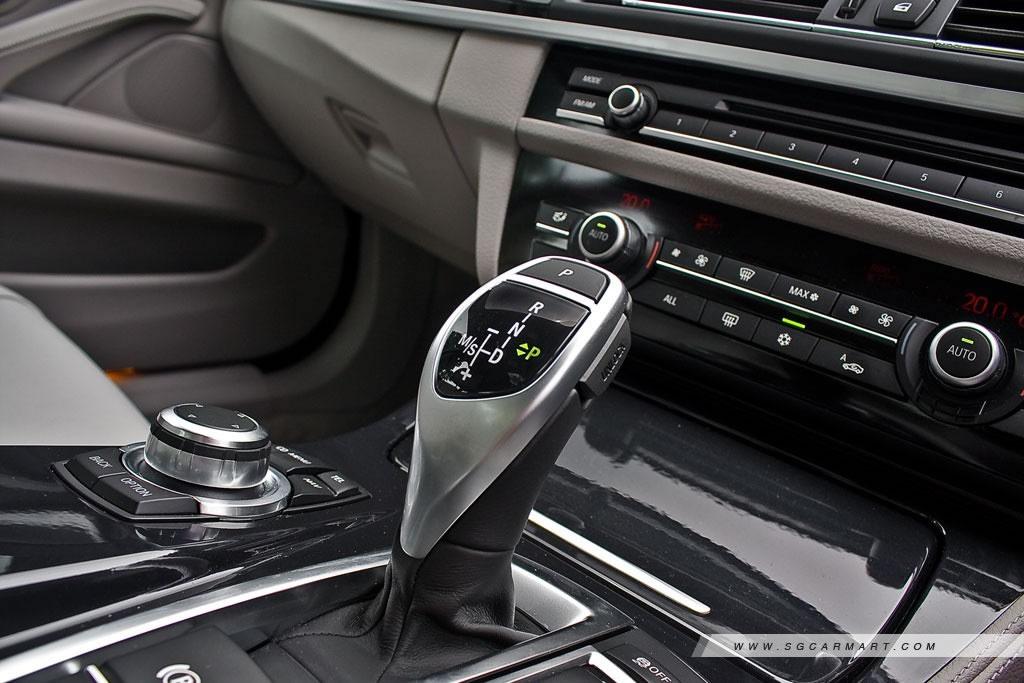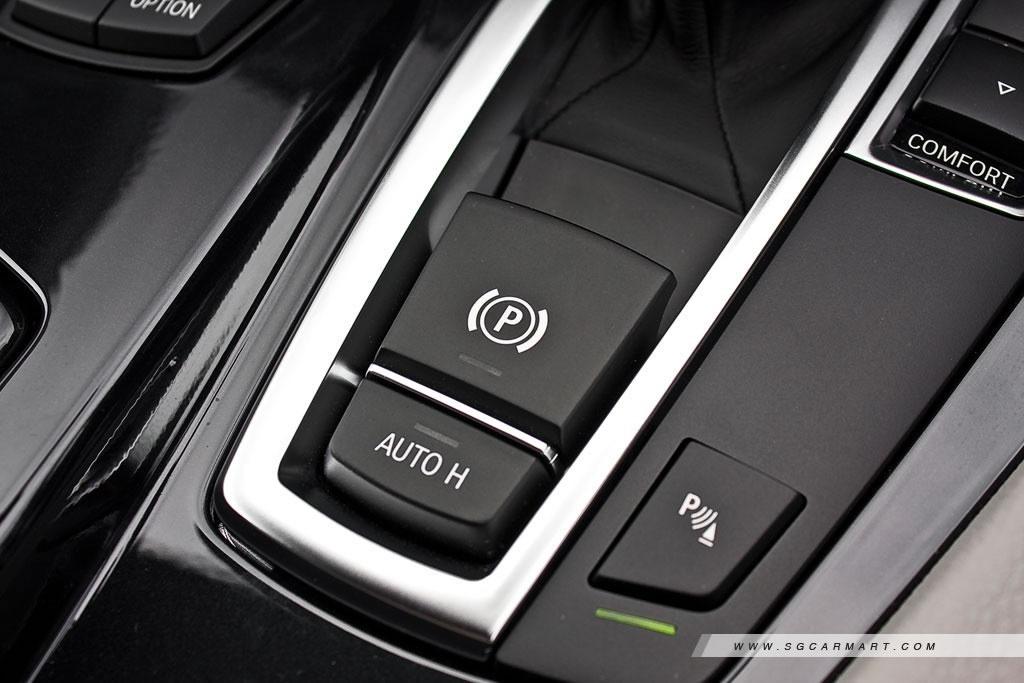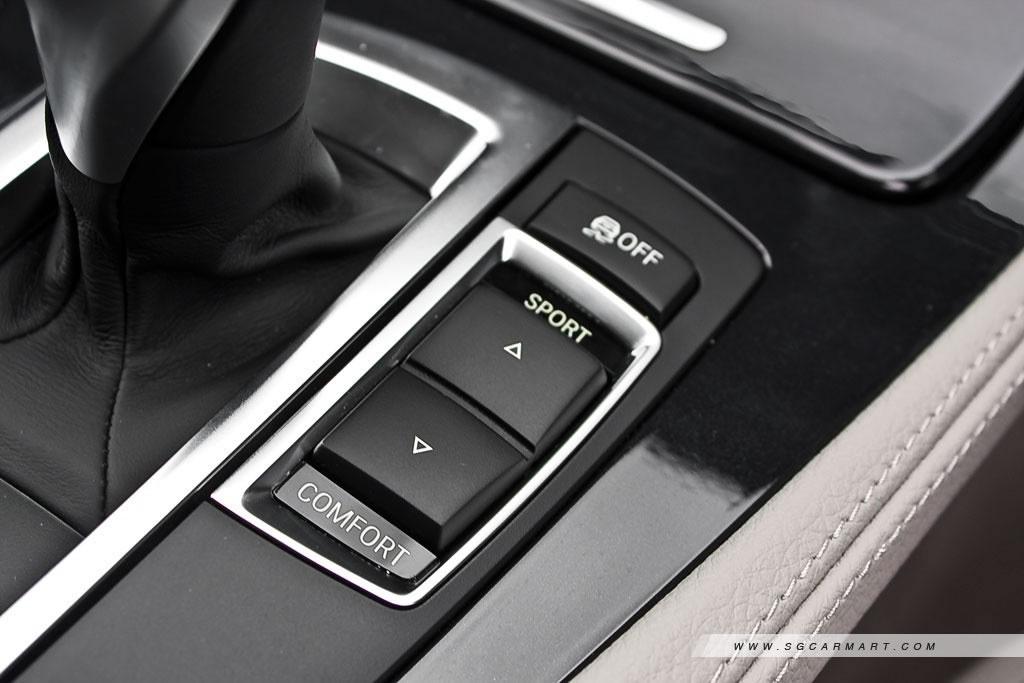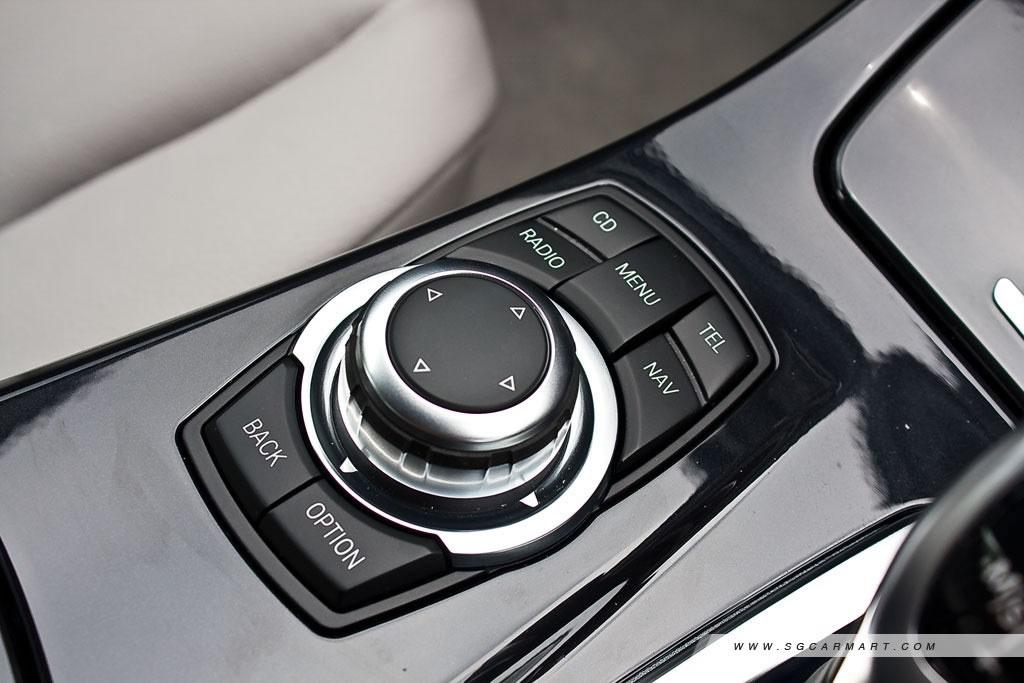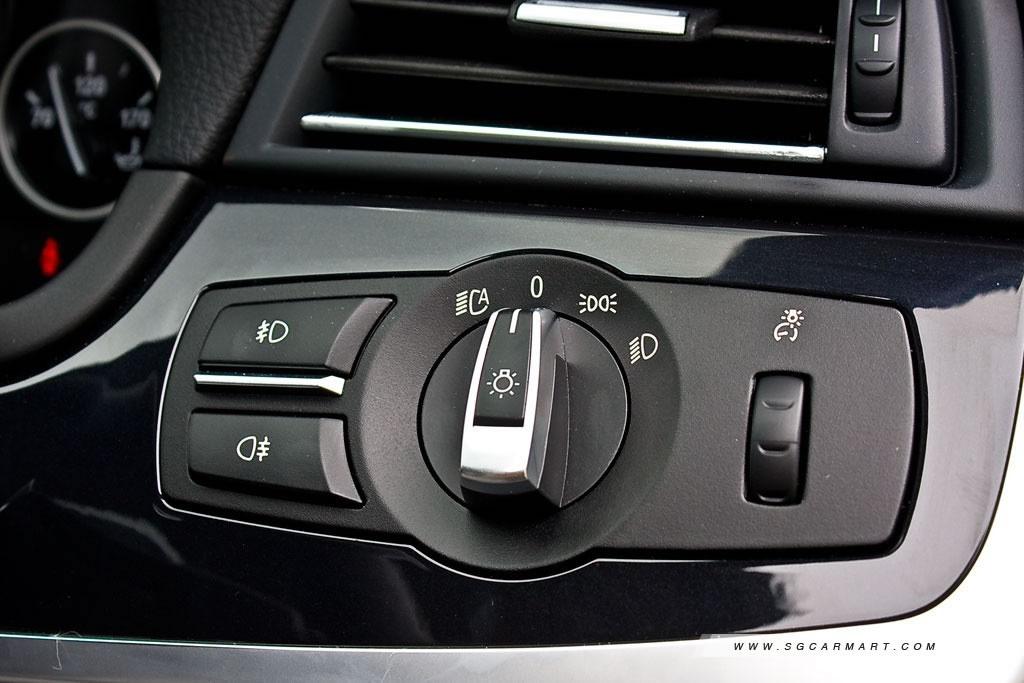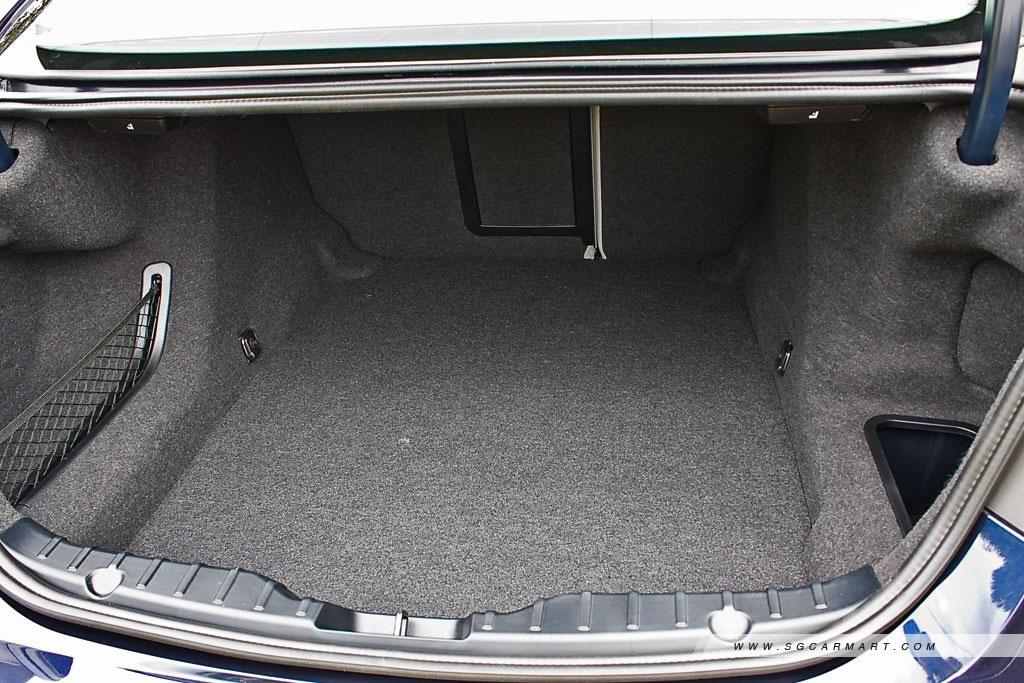BMW 5 Series 520i (A) Review
02 Feb 2012|56,805 views
BMW's rise to the top of the sales charts have been nothing short of astonishing. Singapore is the only market in the world where a premium carmaker like BMW is the top dog, although the trend is not without precedent. Mercedes-Benz was once briefly king of the hill in the mid-90s with its E-Class, when COE prices mirrored current situations.
While BMW's success in Singapore can be mostly attributed to the revised COE quota structure, the Bavarian carmaker's efforts in product engineering and marketing plays no small part in its ascent to the peak. There has to be a reason why buyers opt for the blue propeller over the three-pointed star or four rings.
The 5 Series, in particular, has been a major hit since its launch in 2010, going on to become the best-selling model locally last year. This is despite a limited range of high-capacity engines in its line-up, with tax-unfriendly 2.5-litre, 3.0-litre and 4.4-litre powerplants.
Now though, BMW has sought to cement its position at the top with the introduction of new 2.0-litre engines for the popular 5 Series. The new four-cylinder turbocharged unit promises improved fuel economy, with no detriment to performance whatsoever. Not to mention the reduction in road tax, which will definitely bring a smile to budget-conscious Singaporeans.
The 520i tested here replaces the top-selling 523i model in BMW's local line-up, and for the first time in a long while, the model designation matches the actual engine capacity. But is smaller better?
While BMW's success in Singapore can be mostly attributed to the revised COE quota structure, the Bavarian carmaker's efforts in product engineering and marketing plays no small part in its ascent to the peak. There has to be a reason why buyers opt for the blue propeller over the three-pointed star or four rings.
The 5 Series, in particular, has been a major hit since its launch in 2010, going on to become the best-selling model locally last year. This is despite a limited range of high-capacity engines in its line-up, with tax-unfriendly 2.5-litre, 3.0-litre and 4.4-litre powerplants.
Now though, BMW has sought to cement its position at the top with the introduction of new 2.0-litre engines for the popular 5 Series. The new four-cylinder turbocharged unit promises improved fuel economy, with no detriment to performance whatsoever. Not to mention the reduction in road tax, which will definitely bring a smile to budget-conscious Singaporeans.
The 520i tested here replaces the top-selling 523i model in BMW's local line-up, and for the first time in a long while, the model designation matches the actual engine capacity. But is smaller better?
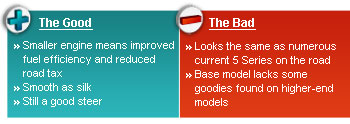 |
Exterior
Aside from the badge on the boot lid, there is very little to differentiate the new 520i from the masses of other 5 Series sedans populating our roads out there. The new 17-inch alloy wheels are a subtle giveaway, but that's about it.
It's a bit disappointing, but totally understandable. After all, why change a good thing? The 5 Series clearly has its fans, and its restrained looks appeal to its target demographics, mainly middle-aged businessmen or executives who are on the midway point to success at the top.
Asians are a conservative lot anyway, and they find no need to shout out their achievements with flashy designs. The 5 Series blends in well with the crowd, greatly helped by the fact that there are so many of its kind out there. A self-fulfilling prophecy perhaps.
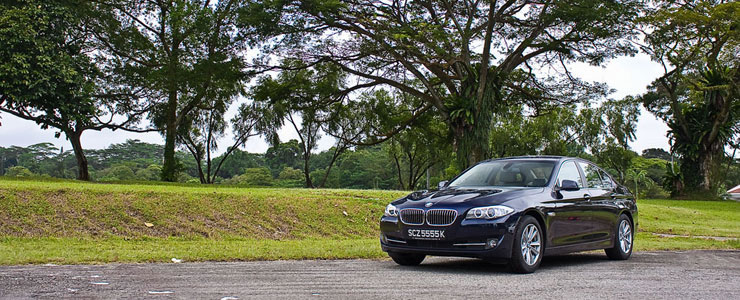 |
BMW's rise to the top of the sales charts have been nothing short of astonishing. Singapore is the only market in the world where a premium carmaker like BMW is the top dog, although the trend is not without precedent. Mercedes-Benz was once briefly king of the hill in the mid-90s with its E-Class, when COE prices mirrored current situations.
While BMW's success in Singapore can be mostly attributed to the revised COE quota structure, the Bavarian carmaker's efforts in product engineering and marketing plays no small part in its ascent to the peak. There has to be a reason why buyers opt for the blue propeller over the three-pointed star or four rings.
The 5 Series, in particular, has been a major hit since its launch in 2010, going on to become the best-selling model locally last year. This is despite a limited range of high-capacity engines in its line-up, with tax-unfriendly 2.5-litre, 3.0-litre and 4.4-litre powerplants.
Now though, BMW has sought to cement its position at the top with the introduction of new 2.0-litre engines for the popular 5 Series. The new four-cylinder turbocharged unit promises improved fuel economy, with no detriment to performance whatsoever. Not to mention the reduction in road tax, which will definitely bring a smile to budget-conscious Singaporeans.
The 520i tested here replaces the top-selling 523i model in BMW's local line-up, and for the first time in a long while, the model designation matches the actual engine capacity. But is smaller better?
While BMW's success in Singapore can be mostly attributed to the revised COE quota structure, the Bavarian carmaker's efforts in product engineering and marketing plays no small part in its ascent to the peak. There has to be a reason why buyers opt for the blue propeller over the three-pointed star or four rings.
The 5 Series, in particular, has been a major hit since its launch in 2010, going on to become the best-selling model locally last year. This is despite a limited range of high-capacity engines in its line-up, with tax-unfriendly 2.5-litre, 3.0-litre and 4.4-litre powerplants.
Now though, BMW has sought to cement its position at the top with the introduction of new 2.0-litre engines for the popular 5 Series. The new four-cylinder turbocharged unit promises improved fuel economy, with no detriment to performance whatsoever. Not to mention the reduction in road tax, which will definitely bring a smile to budget-conscious Singaporeans.
The 520i tested here replaces the top-selling 523i model in BMW's local line-up, and for the first time in a long while, the model designation matches the actual engine capacity. But is smaller better?
 |
Exterior
Aside from the badge on the boot lid, there is very little to differentiate the new 520i from the masses of other 5 Series sedans populating our roads out there. The new 17-inch alloy wheels are a subtle giveaway, but that's about it.
It's a bit disappointing, but totally understandable. After all, why change a good thing? The 5 Series clearly has its fans, and its restrained looks appeal to its target demographics, mainly middle-aged businessmen or executives who are on the midway point to success at the top.
Asians are a conservative lot anyway, and they find no need to shout out their achievements with flashy designs. The 5 Series blends in well with the crowd, greatly helped by the fact that there are so many of its kind out there. A self-fulfilling prophecy perhaps.
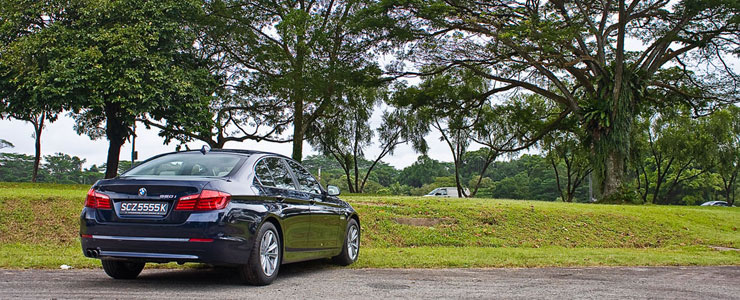 |
The Drive
But none of that matters, because ultimately, a BMW is all about the driving experience.
And in that aspect, it excels. The 520i offers decent performance, delivered in a way that's as smooth as whipped cream. There is some mild lag from the turbocharged four-cylinder powerplant upon move off, but that is easily dealt with once the right pedal moves towards the floor.
The eight-speed automatic transmission is equally efficient at harnessing that power, shifting seamlessly as you power past traffic. The engine might be smaller in capacity, but it loses little over its bigger-engined brothers.
That all-round smoothness also translates into its ride, with the 520i soaking up most road undulations with the littlest of fuss. Some may decry the car as a softie, but in a stressful urban environment like Singapore, a quiet and pliant ride goes a long way towards making life easier for all.
New for the revised 5 Series is the Eco Pro driving mode, which was first seen in the recently launched 1 Series, and utilises BMW's EfficientDynamics philosophy to help achieve optimum fuel efficiency, by actively reducing the strength of the air conditioning and throttle response, among others. A start-stop feature is also part of the system, but the engine cut-out feels as intrusive as most other systems we've experienced thus far.
But none of that matters, because ultimately, a BMW is all about the driving experience.
And in that aspect, it excels. The 520i offers decent performance, delivered in a way that's as smooth as whipped cream. There is some mild lag from the turbocharged four-cylinder powerplant upon move off, but that is easily dealt with once the right pedal moves towards the floor.
The eight-speed automatic transmission is equally efficient at harnessing that power, shifting seamlessly as you power past traffic. The engine might be smaller in capacity, but it loses little over its bigger-engined brothers.
That all-round smoothness also translates into its ride, with the 520i soaking up most road undulations with the littlest of fuss. Some may decry the car as a softie, but in a stressful urban environment like Singapore, a quiet and pliant ride goes a long way towards making life easier for all.
New for the revised 5 Series is the Eco Pro driving mode, which was first seen in the recently launched 1 Series, and utilises BMW's EfficientDynamics philosophy to help achieve optimum fuel efficiency, by actively reducing the strength of the air conditioning and throttle response, among others. A start-stop feature is also part of the system, but the engine cut-out feels as intrusive as most other systems we've experienced thus far.
In the corners, the 520i is as sharp and precise as one would expect from a Bimmer. However, the steering feels a bit dead in feel, and the softly-sprung suspension means that there is some noticeable body roll. Overall though, the 520i is still ahead of its rivals dynamically, but the gap is definitely closing.
Conclusion
Introducing a new, smaller engine into a popular mid-sized car is an almost guaranteed formula for sales success here in Singapore. After all, most Singaporeans tend to opt for the "big body, small engine" principle when it comes to cars, for obvious practical reasons.
With that in mind, the 520i's journey to the top of the charts seems all but sealed, even before taking into account its impressive new powerplant and all-round driving abilities. But to put its achievements down to mere penny-pinching would be doing the 520i an injustice, for it is a very capable car in its own right.
What do you think? Jot down your opinions at the comment box below.
Conclusion
Introducing a new, smaller engine into a popular mid-sized car is an almost guaranteed formula for sales success here in Singapore. After all, most Singaporeans tend to opt for the "big body, small engine" principle when it comes to cars, for obvious practical reasons.
With that in mind, the 520i's journey to the top of the charts seems all but sealed, even before taking into account its impressive new powerplant and all-round driving abilities. But to put its achievements down to mere penny-pinching would be doing the 520i an injustice, for it is a very capable car in its own right.
What do you think? Jot down your opinions at the comment box below.
BMW's rise to the top of the sales charts have been nothing short of astonishing. Singapore is the only market in the world where a premium carmaker like BMW is the top dog, although the trend is not without precedent. Mercedes-Benz was once briefly king of the hill in the mid-90s with its E-Class, when COE prices mirrored current situations.
While BMW's success in Singapore can be mostly attributed to the revised COE quota structure, the Bavarian carmaker's efforts in product engineering and marketing plays no small part in its ascent to the peak. There has to be a reason why buyers opt for the blue propeller over the three-pointed star or four rings.
The 5 Series, in particular, has been a major hit since its launch in 2010, going on to become the best-selling model locally last year. This is despite a limited range of high-capacity engines in its line-up, with tax-unfriendly 2.5-litre, 3.0-litre and 4.4-litre powerplants.
Now though, BMW has sought to cement its position at the top with the introduction of new 2.0-litre engines for the popular 5 Series. The new four-cylinder turbocharged unit promises improved fuel economy, with no detriment to performance whatsoever. Not to mention the reduction in road tax, which will definitely bring a smile to budget-conscious Singaporeans.
The 520i tested here replaces the top-selling 523i model in BMW's local line-up, and for the first time in a long while, the model designation matches the actual engine capacity. But is smaller better?
While BMW's success in Singapore can be mostly attributed to the revised COE quota structure, the Bavarian carmaker's efforts in product engineering and marketing plays no small part in its ascent to the peak. There has to be a reason why buyers opt for the blue propeller over the three-pointed star or four rings.
The 5 Series, in particular, has been a major hit since its launch in 2010, going on to become the best-selling model locally last year. This is despite a limited range of high-capacity engines in its line-up, with tax-unfriendly 2.5-litre, 3.0-litre and 4.4-litre powerplants.
Now though, BMW has sought to cement its position at the top with the introduction of new 2.0-litre engines for the popular 5 Series. The new four-cylinder turbocharged unit promises improved fuel economy, with no detriment to performance whatsoever. Not to mention the reduction in road tax, which will definitely bring a smile to budget-conscious Singaporeans.
The 520i tested here replaces the top-selling 523i model in BMW's local line-up, and for the first time in a long while, the model designation matches the actual engine capacity. But is smaller better?
 |
Exterior
Aside from the badge on the boot lid, there is very little to differentiate the new 520i from the masses of other 5 Series sedans populating our roads out there. The new 17-inch alloy wheels are a subtle giveaway, but that's about it.
It's a bit disappointing, but totally understandable. After all, why change a good thing? The 5 Series clearly has its fans, and its restrained looks appeal to its target demographics, mainly middle-aged businessmen or executives who are on the midway point to success at the top.
Asians are a conservative lot anyway, and they find no need to shout out their achievements with flashy designs. The 5 Series blends in well with the crowd, greatly helped by the fact that there are so many of its kind out there. A self-fulfilling prophecy perhaps.
 |
BMW's rise to the top of the sales charts have been nothing short of astonishing. Singapore is the only market in the world where a premium carmaker like BMW is the top dog, although the trend is not without precedent. Mercedes-Benz was once briefly king of the hill in the mid-90s with its E-Class, when COE prices mirrored current situations.
While BMW's success in Singapore can be mostly attributed to the revised COE quota structure, the Bavarian carmaker's efforts in product engineering and marketing plays no small part in its ascent to the peak. There has to be a reason why buyers opt for the blue propeller over the three-pointed star or four rings.
The 5 Series, in particular, has been a major hit since its launch in 2010, going on to become the best-selling model locally last year. This is despite a limited range of high-capacity engines in its line-up, with tax-unfriendly 2.5-litre, 3.0-litre and 4.4-litre powerplants.
Now though, BMW has sought to cement its position at the top with the introduction of new 2.0-litre engines for the popular 5 Series. The new four-cylinder turbocharged unit promises improved fuel economy, with no detriment to performance whatsoever. Not to mention the reduction in road tax, which will definitely bring a smile to budget-conscious Singaporeans.
The 520i tested here replaces the top-selling 523i model in BMW's local line-up, and for the first time in a long while, the model designation matches the actual engine capacity. But is smaller better?
While BMW's success in Singapore can be mostly attributed to the revised COE quota structure, the Bavarian carmaker's efforts in product engineering and marketing plays no small part in its ascent to the peak. There has to be a reason why buyers opt for the blue propeller over the three-pointed star or four rings.
The 5 Series, in particular, has been a major hit since its launch in 2010, going on to become the best-selling model locally last year. This is despite a limited range of high-capacity engines in its line-up, with tax-unfriendly 2.5-litre, 3.0-litre and 4.4-litre powerplants.
Now though, BMW has sought to cement its position at the top with the introduction of new 2.0-litre engines for the popular 5 Series. The new four-cylinder turbocharged unit promises improved fuel economy, with no detriment to performance whatsoever. Not to mention the reduction in road tax, which will definitely bring a smile to budget-conscious Singaporeans.
The 520i tested here replaces the top-selling 523i model in BMW's local line-up, and for the first time in a long while, the model designation matches the actual engine capacity. But is smaller better?
 |
Exterior
Aside from the badge on the boot lid, there is very little to differentiate the new 520i from the masses of other 5 Series sedans populating our roads out there. The new 17-inch alloy wheels are a subtle giveaway, but that's about it.
It's a bit disappointing, but totally understandable. After all, why change a good thing? The 5 Series clearly has its fans, and its restrained looks appeal to its target demographics, mainly middle-aged businessmen or executives who are on the midway point to success at the top.
Asians are a conservative lot anyway, and they find no need to shout out their achievements with flashy designs. The 5 Series blends in well with the crowd, greatly helped by the fact that there are so many of its kind out there. A self-fulfilling prophecy perhaps.
 |
The Drive
But none of that matters, because ultimately, a BMW is all about the driving experience.
And in that aspect, it excels. The 520i offers decent performance, delivered in a way that's as smooth as whipped cream. There is some mild lag from the turbocharged four-cylinder powerplant upon move off, but that is easily dealt with once the right pedal moves towards the floor.
The eight-speed automatic transmission is equally efficient at harnessing that power, shifting seamlessly as you power past traffic. The engine might be smaller in capacity, but it loses little over its bigger-engined brothers.
That all-round smoothness also translates into its ride, with the 520i soaking up most road undulations with the littlest of fuss. Some may decry the car as a softie, but in a stressful urban environment like Singapore, a quiet and pliant ride goes a long way towards making life easier for all.
New for the revised 5 Series is the Eco Pro driving mode, which was first seen in the recently launched 1 Series, and utilises BMW's EfficientDynamics philosophy to help achieve optimum fuel efficiency, by actively reducing the strength of the air conditioning and throttle response, among others. A start-stop feature is also part of the system, but the engine cut-out feels as intrusive as most other systems we've experienced thus far.
But none of that matters, because ultimately, a BMW is all about the driving experience.
And in that aspect, it excels. The 520i offers decent performance, delivered in a way that's as smooth as whipped cream. There is some mild lag from the turbocharged four-cylinder powerplant upon move off, but that is easily dealt with once the right pedal moves towards the floor.
The eight-speed automatic transmission is equally efficient at harnessing that power, shifting seamlessly as you power past traffic. The engine might be smaller in capacity, but it loses little over its bigger-engined brothers.
That all-round smoothness also translates into its ride, with the 520i soaking up most road undulations with the littlest of fuss. Some may decry the car as a softie, but in a stressful urban environment like Singapore, a quiet and pliant ride goes a long way towards making life easier for all.
New for the revised 5 Series is the Eco Pro driving mode, which was first seen in the recently launched 1 Series, and utilises BMW's EfficientDynamics philosophy to help achieve optimum fuel efficiency, by actively reducing the strength of the air conditioning and throttle response, among others. A start-stop feature is also part of the system, but the engine cut-out feels as intrusive as most other systems we've experienced thus far.
In the corners, the 520i is as sharp and precise as one would expect from a Bimmer. However, the steering feels a bit dead in feel, and the softly-sprung suspension means that there is some noticeable body roll. Overall though, the 520i is still ahead of its rivals dynamically, but the gap is definitely closing.
Conclusion
Introducing a new, smaller engine into a popular mid-sized car is an almost guaranteed formula for sales success here in Singapore. After all, most Singaporeans tend to opt for the "big body, small engine" principle when it comes to cars, for obvious practical reasons.
With that in mind, the 520i's journey to the top of the charts seems all but sealed, even before taking into account its impressive new powerplant and all-round driving abilities. But to put its achievements down to mere penny-pinching would be doing the 520i an injustice, for it is a very capable car in its own right.
What do you think? Jot down your opinions at the comment box below.
Conclusion
Introducing a new, smaller engine into a popular mid-sized car is an almost guaranteed formula for sales success here in Singapore. After all, most Singaporeans tend to opt for the "big body, small engine" principle when it comes to cars, for obvious practical reasons.
With that in mind, the 520i's journey to the top of the charts seems all but sealed, even before taking into account its impressive new powerplant and all-round driving abilities. But to put its achievements down to mere penny-pinching would be doing the 520i an injustice, for it is a very capable car in its own right.
What do you think? Jot down your opinions at the comment box below.
Also read our comparison article on:
BMW 5 Series 528i vs Jaguar XF 2.0 vs Lexus GS Turbo 2.0Car Information
BMW 5 Series Sedan 520i (A)
CAT B|Petrol|15.6km/L
Horsepower
135kW (181 bhp)
Torque
270 Nm
Acceleration
7.9sec (0-100km /hr)
This model is no longer being sold by local distributor
All Used BMW 5 Series SedanThank You For Your Subscription.
